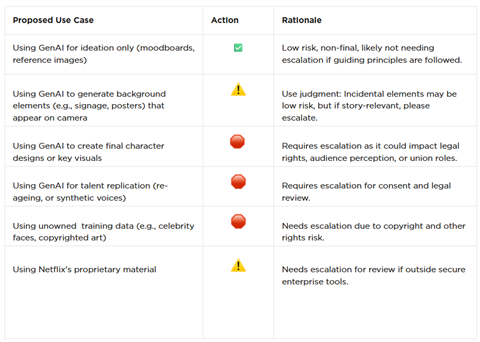Streaming giant gives OK for use in ideation, but any further use to be escalated to the company

Netflix has revealed its guidelines for using generative AI in productions, giving the OK for its use in ideation.
The streaming giant has already revealed that AI was used to cut VFX cost on sci-fi series The Eternaut, and it recently introduced generative AI in its mobile search function.
When it comes to production companies delivering shows to Netflix, it has stipulated that use in ideation, for example in moodboards and for reference images is acceptable as long as users make the company aware it is happening.
However, further use must be escalated to a production company’s Netflix contact to receive permission, in most cases. There are also five “guiding principles” that should be followed in all cases, which include avoiding replication of unowned or copyrighted material, making sure tools don’t store information, and that generated material isn’t part of final deliverables.
Netflix’s GenAI guiding principles
1. The outputs do not replicate or substantially recreate identifiable characteristics of unowned or copyrighted material, or infringe any copyright-protected works
2. The generative tools used do not store, reuse, or train on production data inputs or outputs.
3. Where possible, generative tools are used in an enterprise-secured environment to safeguard inputs.
4. Generated material is temporary and not part of the final deliverables.
5. GenAI is not used to replace or generate new talent performances or union-covered work without consent.
Written approval from Netflix is needed in a number of cases, split into Data Use, Creative Output, Talent & Performance, and Ethics & Representation.
In terms of data use, approval is necessary to input Netflix-owned materials (e.g., unreleased assets, scripts, production images) or personal data (e.g., cast or crew details). It is also instructed to not train or fine-tune models using material from artists, performers, or other rights holders unless you have the proper legal clearance. There are a number of tools covered by Netflix Enterprise Agreements that aim to provide security on this front.
Creatively, approval is also needed to “generate main characters, key visual elements, or fictional settings that are central to the story,” and it is advised to “avoid using inputs (e.g., prompts, images) that, ”reference copyrighted materials or likenesses of public figures or deceased individuals without appropriate permissions”.
Netflix GenAI “Use Case Matrix”

Explicit and documented consent is needed to create digital performers, voices, or likenesses of real talent, and producers should, “be cautious when making changes that affect a performance’s emotional tone, delivery, or intent.” This includes using visual ADR to lip-sync to new audio.
Netflix also rules that producers should, “avoid creating content that could be mistaken for real events, people, or statements if they never actually occurred,” such as a background news report. In addition, GenAI use should, “not replace or materially impact work typically done by union-represented individuals, including actors, writers, or crew members, without proper approvals or agreements.”
The full guidelines can be found here. Custom workflows used by vendors or AI studios, whether contracted by production partners or Netflix itself, must pass the guidelines at every step of their pipeline.
AI Creative Summit 2025

Learn more about the transformative role of artificial intelligence in the entertainment industry at the AI Creative Summit, on 18 November at BFI Southbank, London.
The summit will focus on how AI is reshaping creative processes, production efficiencies, and decision-making within film and television, while also covering the future policies needed to ensure responsible, ethical, and sustainable integration of AI technologies.
It includes live demos and honest debate on everything from AI in production strategy and post, to legal frameworks, ethics, and creativity at scale.
Learn more and secure your ticket here.








No comments yet